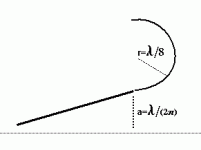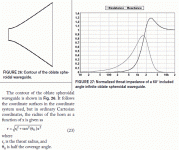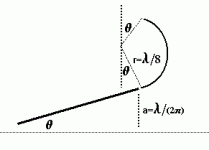Just to clarify: when you say that waveguide theory doesn't assume that the wavefront is perpendicular to the wall, you mean the incident wavefront, and not the total field?
Yes, Bjorn, you are quite correct and it is easy to see how we both might have gotten confused, just so long as we are on the same page now. The total field must be perpendicular, but not the incident and the reflected waves, just the sum.
Webster really made no assumptions about the wavefronts and hence he did not have to specifically apply any angular boundary conditions. This led to a simple theory, but one that was IMO fatally flawed because it would allow for shapes that would require impossible wavefronts, such as tratrix. By specifically requiring the angular boundary constraint, a waveguide theory forced the possibility of HOMs, which we now know do exist and can be a significant factor. When I first wrote about waveguides even I did not anticipate the significance of HOMs.
Thanks for bringing this up because if you were confused then I am sure that others would be as well.
so maybe we can get a actual thoughtful comment on this now?
I am not sure that I can comment much. The RHS does look better in this comparison, but I am not sure that means anything without knowing all of the specifics. For example, are the two diaphragm areas the same? If not then its apples and oranges. And what about other frequencies? Maybe the diagrams flip at other frequencies. Oversimplifying a discussion does no one any good.
It proves that the waveforms are not always flat and they are different for different devices, but beyond that one can't say very much. With this limited data you can't say that one is better than the other in the big picture.
Last edited:
some on the method in the paper http://www.conforg.fr/cfadaga2004/cdrom/data/procs/articles/000162.pdf
his PhD Thesis: http://darwin.bth.rwth-aachen.de/opus3/volltexte/2006/1557/pdf/Makarski_Michael.pdf
his PhD Thesis: http://darwin.bth.rwth-aachen.de/opus3/volltexte/2006/1557/pdf/Makarski_Michael.pdf
Horn HOM Propagation
The Issue of HOMs was addressed by Stevenson in 1951 [1]
Here is a more recent article [2], published on the web, that references his work.
Regards,
WHG
References:
[1]
Title: Exact and Approximate Equations for Wave Propagation in Acoustic Horns
Author: A.F. Stevenson
Abstract: Exact equations are given for the propagation of acoustic waves in horns of arbitrary shape. These equations are similar to, though simpler than, the equations previously found for electromagnetic horns, and can be regarded as giving rise to an infinite number of coupled modes of propagation. If the coupling is neglected, the equation for the fundamental mode is the familiar one, but the theory also furnishes equations for the higher modes. The error involved in neglecting coupling is discussed.
Publication: Journal of Applied Physics, Dec-1951, Vol. 22, No. 12, pp. 1461-1463
[2]
The Issue of HOMs was addressed by Stevenson in 1951 [1]
Here is a more recent article [2], published on the web, that references his work.
Regards,
WHG
References:
[1]
Title: Exact and Approximate Equations for Wave Propagation in Acoustic Horns
Author: A.F. Stevenson
Abstract: Exact equations are given for the propagation of acoustic waves in horns of arbitrary shape. These equations are similar to, though simpler than, the equations previously found for electromagnetic horns, and can be regarded as giving rise to an infinite number of coupled modes of propagation. If the coupling is neglected, the equation for the fundamental mode is the familiar one, but the theory also furnishes equations for the higher modes. The error involved in neglecting coupling is discussed.
Publication: Journal of Applied Physics, Dec-1951, Vol. 22, No. 12, pp. 1461-1463
[2]
Attachments
Yes, Bjorn, you are quite correct and it is easy to see how we both might have gotten confused, just so long as we are on the same page now. The total field must be perpendicular, but not the incident and the reflected waves, just the sum.
Good, then we agree
Webster really made no assumptions about the wavefronts and hence he did not have to specifically apply any angular boundary conditions.
It is interesting to note that Webster himself pointed out the approximate nature of his theory: "I feel that the above theory, while merely an approximation as to accuracy, will go far toward enabling us to complete the theory of musical instruments." And William Hall, in his 1932 JASA paper "Comments on the theory of horns", writes: "The use of such approximate methods in the theory is justified only by the approximate nature of the results it is desired to obtain." So it was known that the theory had shortcomings, but the knowledge does not seem to have penetrated through to the audio engineers designing horns.
Thanks for bringing this up because if you were confused then I am sure that others would be as well.
One more thing I would like to know, though. You wrote "No other theory does this, i.e. all other theories assume the wavefront is perpendicular." Theories, plural. I just would like to know what theories, apart from horn theory, you are thinking of? Transmission matrix formulations and lumped parameter approximations? Still there are other methods, like the HF approximation of geometrical acoustics, that do not assume perpendicular incidence. And then you have the full 3D wave equation, of course.
-Bjørn
thanks for the refs and pdf Whgeiger 
.
Somebody help about OSWG Length formula?
Total L (with rouded 3rd part), and L of the 2nd conical part.
And it is not quite clear for the final Mouth width and before that width of just conical part also...
I found some infos but thay are not clear or false...
Thanks
.
I have now in the sys sort of Exponentioal-Hyperbolic horn
(to many gain, and pressure)
and want to try other type, OSWG first, and maybe pure Exponential later
Thanks
.
Somebody help about OSWG Length formula?
Total L (with rouded 3rd part), and L of the 2nd conical part.
And it is not quite clear for the final Mouth width and before that width of just conical part also...
I found some infos but thay are not clear or false...
Thanks
.
I have now in the sys sort of Exponentioal-Hyperbolic horn
(to many gain, and pressure)
and want to try other type, OSWG first, and maybe pure Exponential later
Thanks
ZZZ, take a peak at Mr Earls signature. There is link with PDF chapters of "Audio transducers" book and find the chapter "Waveguides". There are all of the formulas you need.
EDIT: here it is http://gedlee.azurewebsites.net/downloads/AT/Chapter_6.pdf
EDIT: here it is http://gedlee.azurewebsites.net/downloads/AT/Chapter_6.pdf
Last edited:
Hi Zvu
I went through the liked article, but unfortunately there is no explicit discussion about the
length or Mouth end width...
But I found many other useful things for me
.
The Q is still active - please something about the Lenght and width of the total WG
and some datas for the last rounded section.
I went through the liked article, but unfortunately there is no explicit discussion about the
length or Mouth end width...
But I found many other useful things for me
.
The Q is still active - please something about the Lenght and width of the total WG
and some datas for the last rounded section.
It just seems to me that everyone has touch on a piece of the technology, but integration of the knowledge is necessary to optimize a design.
Reflections make create sustaining HOMs, or fast decaying HOMs. Generally the prior will sound like tone coloration, and the latter will sound like defocus or fuzziness. There is no perfect solution, but the trick is finding the best balancing point. This is due to the wide band nature of audio. The OS design seemed to have focused efforts around the highest end if the horn. It is a design choice. If it is used for a super tweeter in a narrow band, I think it is great.
Reflections make create sustaining HOMs, or fast decaying HOMs. Generally the prior will sound like tone coloration, and the latter will sound like defocus or fuzziness. There is no perfect solution, but the trick is finding the best balancing point. This is due to the wide band nature of audio. The OS design seemed to have focused efforts around the highest end if the horn. It is a design choice. If it is used for a super tweeter in a narrow band, I think it is great.
Hi Zvu
I went through the liked article, but unfortunately there is no explicit discussion about the
length or Mouth end width...
But I found many other useful things for me
.
The Q is still active - please something about the Lenght and width of the total WG
and some datas for the last rounded section.
The length can be set at will, just as it can with any horn. I set the length such that the mouth width is at ka=1->2 at the lowest intended frequency and then use a large round-over (larger the better, but the waveguide gets wider.) There is no magic to it.
OK partially understood, thanks. 
.
what is "ka" some product k x a, or some variable?
and range from 1 to more than 2 ?
.
I have in mind rounded end, but there are 2 ways
1. from tangent angle of the conical part to say 90deg, smooth ending..
2. from end edge point simple circle part. Where r of the circle, of the last section of the horn somehow "as is"
.
I solve for booth, but have simulation model just for radiused end, angle continuing from
conical part tangent angle to 90deg or less. And according to sim, much better results are with radiused end then "naked" 2 section of the horn. *without radiused end.
but, the horn final radius is significantly larger...
.
what is "ka" some product k x a, or some variable?
and range from 1 to more than 2 ?
.
I have in mind rounded end, but there are 2 ways
1. from tangent angle of the conical part to say 90deg, smooth ending..
2. from end edge point simple circle part. Where r of the circle, of the last section of the horn somehow "as is"
.
I solve for booth, but have simulation model just for radiused end, angle continuing from
conical part tangent angle to 90deg or less. And according to sim, much better results are with radiused end then "naked" 2 section of the horn. *without radiused end.
but, the horn final radius is significantly larger...
OK partially understood, thanks.
.
what is "ka" some product k x a, or some variable?
and range from 1 to more than 2 ?
.
I have in mind rounded end, but there are 2 ways
1. from tangent angle of the conical part to say 90deg, smooth ending..
2. from end edge point simple circle part. Where r of the circle, of the last section of the horn somehow "as is"
.
I solve for booth, but have simulation model just for radiused end, angle continuing from
conical part tangent angle to 90deg or less. And according to sim, much better results are with radiused end then "naked" 2 section of the horn. *without radiused end.
but, the horn final radius is significantly larger...
Hi Zoran,
As I remebered k=2*pi/Lambda, and a=horn-mouth radius, so the lowest frequency Lambda=Co/Fo is equal to the mouth circumference. Better that the lowest applicable frequency to the horn to be twice of the Fo.
I would a define as the corresponding largest radius of the "linear" wall segment. As I have remembered "ending-rolling part" of the horn mouth has to be done with the radius of about Lambda/8, but gedlee
diyAudio - View Profile: gedlee can help
Attachments
Last edited:
From Keele
X=K/(theta x Fi)
where:
X=horn mouth width or heigth
theta=coverage angle of the horn (total angle...)
Fi=fr. down which coverage angle is maintained, assumed same as the cut of F.
Krec=keeles constant; 25,306 [m x deg. x Hz] for rectangular horh shape
Kcir=keeles constant; 29,707 [m x deg. x Hz] for circular horh shape
.
But is it total horn diameter with radiused 3rd part end, OR just end of the conical section 2nd part?

X=K/(theta x Fi)
where:
X=horn mouth width or heigth
theta=coverage angle of the horn (total angle...)
Fi=fr. down which coverage angle is maintained, assumed same as the cut of F.
Krec=keeles constant; 25,306 [m x deg. x Hz] for rectangular horh shape
Kcir=keeles constant; 29,707 [m x deg. x Hz] for circular horh shape
.
But is it total horn diameter with radiused 3rd part end, OR just end of the conical section 2nd part?
But is it total horn diameter with radiused 3rd part end, OR just end of the conical section 2nd part?

It would be the circumference where the waveguide "would have" intersected the baffle. And remember the radius must be tangent to the waveguide so the above drawing is incorrect.
It would be the circumference where the waveguide "would have" intersected the baffle. And remember the radius must be tangent to the waveguide so the above drawing is incorrect.
Hi gedlee,
You right about my drawing, as did in the hurry. May be this is better.
Regards
Ivica
Attachments
Thanks Ivica
So
k=(2 x PI x Fo) / c ; [Hz x sec / m] or [1/m]
where:
Fo=cutoff fr. [Hz]
c=speed of sound [m/s]
.
So Ka is the product k x a
a =is in range of (1 to 2) / k
.
But what is the a Diameter od radius?
From your sketch it look like the r? Radius, half of the diameter?
.
thanks
So
k=(2 x PI x Fo) / c ; [Hz x sec / m] or [1/m]
where:
Fo=cutoff fr. [Hz]
c=speed of sound [m/s]
.
So Ka is the product k x a
a =is in range of (1 to 2) / k
.
But what is the a Diameter od radius?
From your sketch it look like the r? Radius, half of the diameter?
.
thanks
Thanks GedLee
so the the circumference is area between conical part and radiused part?
and a is Diameter (Diameter =2 x Radius) of that circumference?
.
Baffle, when You said, You mean radiused part, last part of the horn, or something else?
Tx
http://en.wikipedia.org/wiki/Circumference
so the the circumference is area between conical part and radiused part?
and a is Diameter (Diameter =2 x Radius) of that circumference?
.
Baffle, when You said, You mean radiused part, last part of the horn, or something else?
Tx
http://en.wikipedia.org/wiki/Circumference
Last edited:
- Home
- Loudspeakers
- Multi-Way
- Geddes on Waveguides


